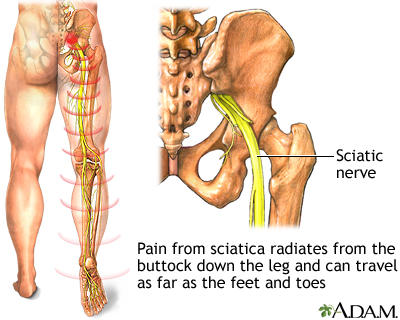Sciatica: defined as pain of an intense and radiating nature down the back of the leg, often reaching to the foot, but commonly to the knee or just the buttock. Since sciatica can be debilitating, we are taking a look at which forms of sciatica that Osteopaths can help.
Your sciatic nerve is not one nerve. It is composed of 5 bundles of nerves that exit from the spine at the L4, L5, S1, S2 and S3 levels. But just because the sciatic nerve is comprised of lower lumbar and upper sacral nerves, doesn’t mean that the levels causing you pain are down lower in your back. The lumbar nerve component starts higher in your spine, around the L1/2 level, then stays within the spinal canal, exiting down lower in the spine. Because of the distance that the sciatic nerve components travel, as well as their extensive distribution into the lower limb muscles, joints, ligaments, arteries and other nerves, sciatic pain can be debilitating.
Where Osteopaths can help is when the sciatic pain is caused by nerve (neural) impingement because of sprained facet joint(s) (little ‘ear’ bits that go up and down from each vertebra making the spine joints). The resultant spasm from injury can caused inflammation of the sciatic nerve at any or all of the 5 nerve components, commonly presenting as shooting pain down the buttock and into the back of the leg. Pain in the front of the leg is most likely coming from a nerve higher up, but Osteopaths can help facet sprains of higher lumbar joints too.
Importantly, correct diagnosis of what is causing sciatica is the most critical aspect of effective treatment and Osteopaths are highly trained health professionals with excellent diagnostic skills – we won’t treat you unless we have a clear diagnosis and plan. Treatment by an Osteopath aims to reduce muscle spasm of the supporting lumbar and deep buttock muscles, releasing restricted (or sprained) facet joints with gentle manipulation and stretching to the affected areas.
Strengthening and toning exercises will be prescribed to assist in recovery, but initially gentle movement and inflammation reduction are the key goals. Conservative (Osteopathy, massage) treatment of sciatica is recommended in the majority of cases unless numbness is experienced in the whole groin, inner thigh and loss of function of bladder is experienced – please get to hospital asap, if this is you. Some of the exercises we use can be viewed on other blog posts, but must be prescribed by your Osteopath first to make sure they are suitable for you.
Check in for more sciatic updates and contact us for more information.
